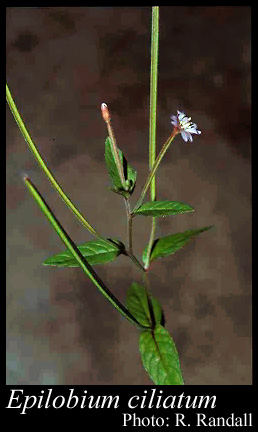- Reference
- Med.Repos. Ser. 2, 5:361 (1808)
- Conservation Code
- Not threatened
- Naturalised Status
- Alien to Western Australia
- Name Status
- Current
Erect perennial or annual (occasionally), herb, 0.15-1.95 m high. Fl. pink-purple, Sep to Nov. Gardens.

Distribution
- IBRA Regions
- Avon Wheatbelt, Jarrah Forest, Swan Coastal Plain.
- IBRA Subregions
- Katanning, Perth, Southern Jarrah Forest.
- IMCRA Regions
- WA South Coast.
- Local Government Areas (LGAs)
- Albany, Bassendean, Belmont, Donnybrook-Balingup, Melville, Pingelly, Serpentine-Jarrahdale, South Perth, Stirling, Swan, Wanneroo.
Management Notes (for the Swan NRM Region)
Alternative Names. Glandular Willow Herb, Fringed Willow Herb.
General Biology. Growth form. Herb. Life form. Perennial. Reproduction. Primarily seed, also crown fragments. Dispersal. Wind, soil. Seedbank persistence. Short, possibly days - 1 year.
Notes. Common weed of nurseries and orchards. Prefers to establish on bare soil. Germinates rapidly in low light conditions, grows vigorously and produces large numbers of wind-dispersed seeds. Produces a rosette as an over wintering structure. Few herbicides provide effective control.
Additional information. Origin. Temperate Asia, Russia, Eastern Asia, North America. Similar native species. E. billardiereanum, E. hirtigerum.
Suggested method of management and control. Prevent plants going to seed. Hand remove small/isolated infestations of seedlings. If hand removing large plants ensure any crown fragments are removed as they may regrow left in the soil. Alternatively spray seedlings with glyphosate. Tolerant to glyphosate in later stages - established plants will resprout after treatment. Herbicides alone will not provide effective control - use a combination of good hygenie and herbicide management. Read the manufacturers' labels and material safety data sheets before using herbicides. For further information consult the Australian Pesticides and Veterinary Medicines Authority to determine the status of permits for your situation or state.
Management Calendar
| Calendar Type | Jan | Feb | Mar | Apr | May | Jun | Jul | Aug | Sep | Oct | Nov | Dec | Comments |
|---|---|---|---|---|---|---|---|---|---|---|---|---|---|
| Germination | U | U | U | ||||||||||
| Active Growth | Y | Y | Y | Y | Y | Y | |||||||
| Flowering | Y | Y | Y | Y | |||||||||
| Fruiting | Y | Y | Y | ||||||||||
| Manual Removal | O | O | O | O | O | Y | Y | Y | Y | Y | O | O | |
| Herbicide Treatment | Y | Y | Y |
Legend: Y = Yes, regularly, O = Occasionally, U = Uncertain, referred by others but not confirmed.
References
- Altland, J. (Undated) Weed Management In Nursery Crops: Northern-willowherb management. Oregon State University Extension Service, Oregon, United States. URL: http://oregonstate.edu/dept/nursery-weeds/startpage.html - Accessed August 2010.
- Brown, K. & Brooks, K. (2002) Bushland Weeds: A Practical Guide to their Management. Environmental Weeds Action Network, Greenwood.
- Bulcke, R., Verstraete, F., Himme, M. & van Stryckers, J. (1987) Biology and control of Epilobium ciliatum Rafin. (syn.: E. adenocaulon Hausskn.). In Proceedings of a meeting of the EC Experts' Group, Dublin, 12-14 June 1985. 57-67.
- Hussey, B.M.J., Keighery, G.J., Dodd, J., Lloyd, S.G. & Cousens, R.D. (2007) Western Weeds. A guide to the weeds of Western Australia. 2nd Edition. The Plant Protection Society of Western Australia, Victoria Park.
- Neal, J.C. & Gordon, I. (2003) Common weeds of container nurseries and their control. The Centre for Native Floriculture, University of Queensland, Brisbane.
- Parsons, W.T. & Cuthbertson, E.G. (2001) Noxious weeds of Australia. 2nd Edition. CSIRO Publishing, Collingwood.
- USDA, ARS, National Genetic Resources Program (2009) Germplasm Resources Information Network - (GRIN). National Germplasm Resources Laboratory, Beltsville, Maryland. URL: https://npgsweb.ars-grin.gov/gringlobal/taxon/taxonomysimple.aspx - Accessed October 2009.